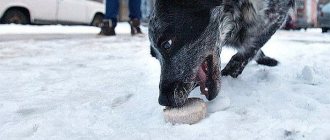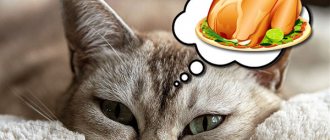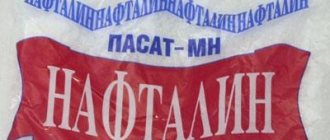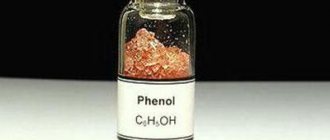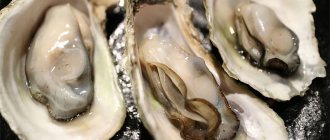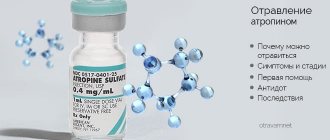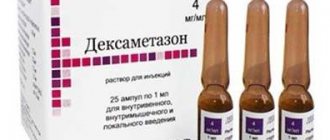Causes of poisoning
Rat poison itself has a distinct unpleasant odor.
But manufacturers of rodent poison give it a tempting meaty aroma that can attract not only rats and mice, but also dogs. The dog can eat the poison itself, or a rodent that has previously been poisoned by it. In both cases, the poison enters the dog's body and is absorbed into the bloodstream through the gastric mucosa.
Rat poison can be specially laid out to kill dogs; not only homeless people, but also pets suffer from this.
How does rat poison affect a dog's body?
If a dog has eaten poison or a poisoned rodent, severe pathological changes begin to occur in its body. Most poisons that are produced to kill rats affect all systems of the animal's body, and lead to painful death.
Below are the main components that can be found in rat poison, and the features of their effect on the dog’s body are discussed:
- Rodenticides (anticoagulants) – these substances, when entering the animal’s body, affect blood clotting. They contribute to the development of massive internal bleeding and can cause hemorrhagic stroke.
- Rat poison is one of the most dangerous poisons for the dog’s body. It leads to damage to the central nervous system, the development of pulmonary edema, and acute heart failure.
- Zinc phosphide – affects the digestive and nervous systems.
Please note that a very small amount of toxic substance (several mg) is required for a dog to be poisoned.
What not to do?
- It is forbidden to induce vomiting in an animal if more than 4 hours have passed since the toxic substance entered the body. During this time, the poison from the stomach already penetrates the intestinal walls;
- It is forbidden to induce vomiting if the dog has disturbances in the functioning of the nervous system: loss of consciousness, convulsions or paralysis.
- Do not give your pet dairy and fermented milk products, vegetable oil, or eggs. If the poisoning was caused by zinc phosphide, such products will only worsen the situation, since they promote the rapid absorption of toxins into the bloodstream.
Main clinical signs of rat poison poisoning in dogs
When poisoned by rat poison, symptoms may appear within the first few hours in dogs. The exception is rodenticides. When consuming them, the first clinical signs may appear after a few days.
Remember that puppies are more sensitive to mouse poison and their symptoms develop much faster. The lethal dose of poison for a puppy is less than for an adult dog.
If a dog has eaten a poisoned mouse, the onset of symptoms may take a little longer.
The table below shows the main symptoms of rat poison poisoning depending on the active substance:
| Name of the poison | Main symptoms |
| Rodenticides |
|
| Krysid |
|
| Zinc phosphide |
|
Overdose
Symptoms of overdose may not appear until 48 hours after administration of the drug. Overdoses can cause severe hemorrhage and even death. Overdose amounts have been recorded ranging from 0.99 mg/kg when administered over consecutive days to 4.99 mg/kg as a single dose. In cases of warfarin overdose, standard treatment protocols should be followed, which include the administration of vitamin K to absorb any remaining drug in the stomach.
First aid
If your pet has ingested mouse poison, it should be treated at a veterinary clinic. When the first symptoms of intoxication appear, the animal should be taken to a veterinarian. If for some reason you cannot do this right away (you are outside the city, there is no 24-hour veterinary hospital nearby), start helping him yourself. Your actions will help the dog live to see the vet.
Please note that giving your dog strong medications without a veterinarian's prescription is dangerous. The dosage for an animal is different from that for humans. Also, you will not know what chemical reaction the poison and the drug will enter into.
First aid for dog poisoning consists of the following:
Diet
When the first signs of poisoning appear, remove the bowl of food from the dog. The digestive system needs rest. You can start eating after your veterinarian's permission.
Gastric lavage
Rinse your dog's stomach. To do this you will need a 20 ml syringe. Squirt water into the animal's mouth and press on the root of the tongue to induce vomiting. Pour 20 ml of water into puppies and small dogs, 40 ml for medium-sized dogs, and 60-80 ml for large dogs. Do not add any medicines, herbal infusions or potassium permanganate to the water. Plain water at room temperature is suitable for gastric lavage.
Remember that potassium permanganate, even in a small concentration, can cause burns and intoxication of the mucous membrane of the esophagus and stomach in an animal. Now this substance is prohibited, but many still have it in their home medicine cabinet.
Colon cleansing
Perform colonic lavage with an enema. For rinsing, take a children's enema bulb with a volume of 50-100 ml. Fill the enema with plain water at room temperature and insert it into your dog's rectum. Then, wait until she goes to the toilet and repeat this procedure several more times.
When performing an enema on dogs, a problem may arise - an animal that is used to relieving itself on the street will restrain itself after the enema and ask to go for a walk. In this case, you will have to take out, or take (if there is severe weakness) the dog out into the yard.
Sorbents
Sorbents are substances that bind and remove poisons and toxins from the body.
Give the dog a sorbent to drink. Everyone has Activated Charcoal in their first aid kit. Calculate its dosage for an animal in the same way as for a person: 1 tablet per ten kg of weight. For example, if his weight is 5 kg, you will need half a tablet, and if he weighs 50 kg, 5 tablets. Don’t be afraid to exceed the amount a little; it’s better to let your pet drink a little more sorbent rather than less. For example, if the animal weighs 17 kg, give it 2 tablets.
Getting your dog to swallow a pill is not easy. It is best to grind the required amount of Activated Carbon and dilute it in 10-15 ml of water. Inject this solution into her mouth through a syringe. If she spits out the medicine, try again.
If you have a veterinary sorbent at home and you know the rules for dosing it, you can use it.
Drink plenty of fluids
It is necessary to give your dog water to replenish water losses that occurred during vomiting and diarrhea, and to relieve intoxication in the body.
The animal should be given regular non-carbonated water. The dog needs to pour 10 ml of water into its mouth every 10 minutes (if the dog is very tiny - 5 ml).
Please note that if your dog is poisoned by rodenticides, rinsing the stomach and intestines is prohibited. This may increase internal bleeding. Put the dog on a fast, give it something to drink and sorbents.
Urgent actions
We have already noted that the dose of poison, which is intended to fight mice and rats, is not dangerous for dogs, but only under one important condition, which is timely and competent treatment. First aid consists of the following operational measures:
- you should induce vomiting (to do this, put a little baking soda on your pet’s tongue);
- rinse the stomach, administer a weak solution of potassium permanganate using an enema;
- “feed” the dog activated carbon;
- give a laxative;
- do not feed your pet, and do not limit water consumption, add rice water to the animal’s diet;
- open windows and vents - a sick animal needs fresh air.
Please note that these recommendations apply only in cases where the dog owner is exactly sure which drug caused the intoxication and the approximate time the poison entered (after 4 hours you cannot induce vomiting, the poison has already been absorbed into the blood). In other situations, these activities are unsafe.
Veterinarians warn that in any case, even if the condition improves after taking home measures, further consultation with a specialist is required.
What does treatment at a veterinary hospital consist of?
The veterinarian will first examine the animal and measure its vital signs (pulse, blood pressure, oxygen saturation, body temperature).
The owners should tell the doctor about what happened to the dog: when it happened, what symptoms appeared first, what first aid was given to the dog. In case of rodenticide poisoning, their antidote, vitamin K, is administered . In all other cases, treatment is symptomatic and aimed at removing the poison from the body, replenishing water and electrolyte losses, and treating complications from internal organs. It may consist of the following groups of drugs:
- sorbents;
- saline laxatives;
- enzymes;
- painkillers;
- anti-inflammatory;
- corticosteroids;
- heart medications;
- diuretics;
- solutions for intravenous rehydration;
- antibiotics.
If your animal is in serious condition, it will be kept in the hospital for several days. If the dog is feeling stable, the doctor will explain to you what to do and tell you when to come to him for injections, IVs and examination.
Life-threatening drug
Brodifacoum belongs to a group of strong poisons aimed at exterminating rodents of various species. The substance is obtained artificially, which indicates its complete synthetic composition. This poison cannot be dissolved in an aquatic environment; it is resistant to the influence of external factors and is able to maintain its deadly power for a long time. Even severe frost or scorching sun is not able to destroy the toxic properties of this poison.
The product is available in the form of a whitish powder with a neutral odor or in liquid format of various colors, which require different methods of application. In addition to the active substance, the formula of this product contains a whole set of additives that in every possible way protect the poison from external influences.
Based on the documentation, Brodifacoum is classified as a class 1 extremely toxic substance. Moreover, not only the drug is dangerous, but also its evaporation. They can easily affect the surface of the skin, mucous membranes, or penetrate the body through the respiratory system.
The toxic substance has a complex effect on any living organism, and its main weapon is considered to be the destruction of blood platelets. Coagulation disorders lead to numerous bleedings, which kill all living organisms. Most often, bleeding is observed in the gastrointestinal tract and respiratory system.
Proper use of venom saves lives
Based on the manufacturer's recommendations, Brodifacoum is used as a poisonous additive to all kinds of baits that will be eaten by pests. When working with this poison, you need to ensure a good flow of fresh air into the room, as well as use special clothing and protective equipment for the skin, eyes and respiratory system. Such precautions will help avoid poisoning with a dangerous toxin. To prepare the bait, you need to follow simple steps and mix 1 kg of food with 20 grams. toxic substance, and then place small portions in areas where rats or mice gather. Be sure to check the bait every other day.
Dead rodents are disposed of by burning, as they can cause poisoning in pets. All utensils in which poisoned food for pests is prepared and stored must be labeled and inaccessible to children. With these simple steps you will protect your loved ones from accidentally ingesting poison.
Animal examination
To identify complications from internal organs and systems, the veterinarian may prescribe a number of laboratory and instrumental examinations:
- A general blood test will help identify hemolysis of red blood cells and anemia.
- A general urine test is necessary to diagnose kidney damage.
- A biochemical blood test is performed to determine the performance of the pancreas, liver and kidneys.
- Ultrasound examination (ultrasound) of internal organs can help identify acute damage.
- ECG, echocardiography is indicated for the development of heart failure.
- X-ray of the head - if a hemorrhagic stroke is suspected.
The veterinary clinic may not have sufficient equipment to perform these tests, and you will be sent to another veterinary hospital to complete the diagnosis.
Where to buy an antidote?
The Medimport company offers its clients a variety of veterinary medicines from Europe.
We offer medicines and vaccines at good prices. The medical staff of our online store will help you choose the right product, advise you on the dosage, methods of use, and storage conditions of the drugs.
We guarantee the availability of quality certificates for all products offered, fast delivery to any region of Russia, compliance with the storage conditions of medicines in the warehouse and during delivery.
Prevention of poisoning
Rat poisoning in dogs often results in death. It is much easier to avoid contact of your pet with this poison. Below are tips to help with this:
- Walk your dog on a leash and muzzle. This way you will be sure that your pet will not pick up anything from the ground.
- From an early age, teach your dog that eating anything from the ground is prohibited.
- If deratization (destruction of rodents) is planned in the premises where you live, take the dog to another home for a while (to relatives, friends, or board at a veterinary clinic).
- In the village, prohibit your dog from running around barns, cellars, and chicken coops. There she can find a dead, poisoned mouse.
Poisoning with rat poison in dogs leads to severe damage to the internal organs of the animal and, in the absence of medical care, to death. When the first signs of poisoning develop, take your pet to a veterinary clinic. There he will be given first aid, examined and treated.
Possible consequences
Complications after poisoning with rat poison may be related to the functioning of the liver. It may be difficult to restore blood clotting. Because of this, the dog may have bleeding gums, there will be severe bleeding after injury to internal organs and, consequently, heavy blood loss after wounds.
The recovery period can be lengthy. The average duration of treatment is a month.
Rat poisoning poses a serious risk to dogs. You can’t hesitate and self-medicate! Veterinarian help is needed! If your beloved pet has been poisoned by rodent poison, give him first aid and take him to the doctor! This way you will keep your dog healthy and alive!

